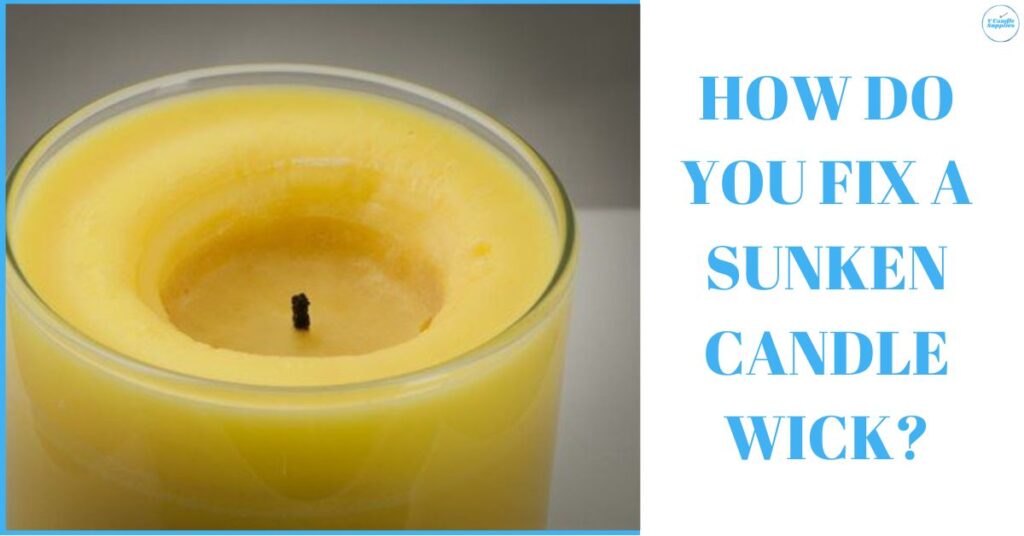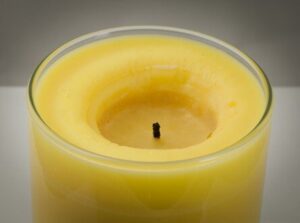COD available for orders below 1500. Shipping Charges will be added at the end while placing the order. Happy Candle 🕯️ Making. Dispatch Timeline - 3 to 4 days minimum due to peak season.
How Do You Fix a Sunken Candle Wick?

Candles have long been cherished for their warm glow and soothing ambiance, transforming ordinary spaces into cozy retreats. However, even the most beautiful candles can encounter a frustrating issue, sunken candle wicks. This common problem, often unnoticed until it’s too late, can significantly diminish the candle’s performance and overall experience.
A sunken wick occurs when the wick becomes embedded in the wax, making it difficult or impossible to light. This not only shortens the life of your candle but can also pose safety concerns. The reasons behind a wick sinking range from manufacturing flaws to incorrect burning practices. Regardless of the cause, addressing this issue is crucial for anyone who enjoys the serene atmosphere candles provide.
In this article, we’ll explore the causes of sunken candle wicks and provide practical solutions to fix them, ensuring your candles continue to burn beautifully and safely.
What Causes a Drowning Wick?

The phenomenon of a sunken wick is not just a minor inconvenience; it’s a result of various factors that can often be controlled or mitigated. This can happen for a few reasons:
- Overpouring Wax: If too much wax is poured around the wick during the candle-making process, the wick can become overwhelmed and sink.
- Wick is Too Short: If the wick is trimmed too short before the candle is lit, it may not have enough length to stay above the surface of the wax as it melts.
- Uneven Burning: Sometimes, if a candle burns unevenly (due to drafts, for example), one side of the wax can melt more than the other, causing the wick to tilt and eventually become buried in the wax.
- Soft Wax: In some cases, especially with softer waxes, the heat of the flame can cause the wax around the wick to melt too quickly, making the wick sink.
The quality of the wax plays a significant role as well. Softer waxes, like soy wax, tend to melt more quickly and in a wider pool, increasing the likelihood of the wick becoming submerged. On the other hand, harder waxes might not melt as uniformly, potentially causing the same issue. The melting point of the wax, influenced by its composition and additives, also affects how the candle burns and, consequently, the wick’s stability.
Burning practices are equally crucial. Inconsistent burning, such as lighting a candle for too short a period, can lead to uneven melting of the wax. This uneven melting, often referred to as tunneling, can leave the wick stranded on a wax ‘island’ or cause it to sink if the surrounding wax collapses. Ensuring that candles are burned long enough for the entire top layer of wax to melt during each use can prevent this issue.
The Impact of Sunken Wicks on Candle
Sunken wicks significantly impact both the performance and safety of candles. From a performance standpoint, a candle with a sunken wick burns inefficiently. It struggles to maintain a flame, and when it does, the flame is often too small to create an adequate melt pool. This inefficient burning leads to a reduction in the candle’s scent throw and an uneven burn, resulting in wasted wax and a shortened candle life.
How can one Prevent Candle Wicks From Sinking?
1- Choosing the Right Wick and Wax
Preventing sunken wicks begins at the very foundation of candle making – selecting the appropriate wick and wax. The right combination of these two elements is crucial for a well-functioning candle.
- Choosing the Right Wick: The candle wick’s size and material are pivotal. A wick that’s too thin may not be able to sustain a strong flame, leading to drowning in the melted wax. Conversely, a wick that’s too thick can cause excessive melting and tunneling. The material of the wick also matters. Cotton candle wicks are a popular choice for their consistent burn, but there are also wood wicks which offer a unique crackling sound and are known for their even burn.
- Selecting Quality Wax: The type of candle wax can greatly influence how a candle burns. Soy wax, for instance, is renowned for its clean and even burn, making it a preferred choice for preventing wick issues. Paraffin wax, while more traditional, can burn faster and hotter, potentially leading to wick problems. Blended waxes can offer a balance between the two, but it’s important to understand their burning characteristics.
2- Proper Candle Burning Practices
Even the best candle making materials can falter without proper burning practices. Here are some guidelines to ensure your candles burn correctly:
- Initial Burn Time: The first burn of a candle sets the stage for its future performance. It’s essential to allow the candle to burn long enough so that the entire top layer of wax melts. This prevents tunneling and reduces the risk of the wick sinking in subsequent burns.
- Regular Burn Duration: Consistency is key. Candles should not be burned for too short or too long in a single session. A general rule of thumb is to burn the candle for about one hour for every inch of its diameter. This ensures an even melt pool and prevents the wick from becoming overwhelmed by wax.
- Environmental Considerations: The environment where a candle is burned can impact its performance. Avoid burning candles in drafty areas, as this can cause uneven burning and wick problems. Ensure the surface is level so the wax can melt uniformly.
By following to these preventative guideline, you can significantly reduce the likelihood of encountering sunken wick issues, ensuring a safer and more enjoyable candle-burning experience.
How to Fix Sunken Candle Wick
Initial Assessment and Safety Precautions
Before attempting to fix a sunken candle wick, it’s important to assess the situation carefully and take necessary safety precautions.
- Examine the Candle: Determine the extent of the wick’s submersion. If the wick is slightly below the wax surface, it may be an easier fix than if it’s deeply embedded.
- Cool Down: Ensure the candle is cool and the wax is solidified before attempting any repairs. Working on a warm candle can be messy and dangerous.
- Prepare Your Workspace: Place the candle on a stable, heat-resistant surface. Have tools like tweezers, a heat source, and wick trimmers on hand.
- Safety First: Keep a fire extinguisher or a bowl of water nearby in case of an accidental ignition. Never leave a candle unattended while attempting to fix it.
Practical Solutions to Fix Sunken Wicks
Once you’ve assessed the situation and taken safety precautions, you can proceed with fixing the sunken wick.
- Soak Up Excess Wax: If there’s a pool of melted wax around the wick, use a paper towel or a cotton pad to gently absorb it. This will expose the wick for easier access.
- Heat to Reveal the Wick: For wicks that are slightly submerged, use a heat gun or a hair dryer on a low setting to gently melt the surrounding wax. Once the wick is exposed, extinguish the flame and let the wax cool.
- Wick Adjustment: If the wick is bent or leaning, straighten it using tweezers. Be gentle to avoid breaking the wick.
- Trim the Wick: Once the wick is exposed and straightened, trim it to the appropriate length (about 1/4 inch) to ensure an even burn.
Alternative Solutions for Severely Damaged Wicks
In cases where the wick is severely damaged or too short to salvage, more drastic measures may be necessary.
- Wick Replacement: For a candle with a deeply buried or damaged wick, consider replacing the wick entirely. This involves melting down the candle, removing the old wick, and inserting a new one. This can be done by placing the candle in a pot of warm water to melt the wax, then pouring it into a new container with a new wick set in place.
- Creating a New Candle: If the original candle is too damaged, use the salvaged wax to create a new candle. Melt the wax as described above, and pour it into a new mold or container with a properly positioned wick.
- DIY Wick Solutions: In a pinch, household items like cotton string or a piece of a clean cotton cloth can be used as a makeshift wick. However, these solutions are temporary and may not offer the best burning experience.
By following these steps, you can effectively address the issue of a sunken candle wick, restoring your candle’s functionality and extending its life. Remember, safety is paramount, so proceed with caution and patience.
Candle Maintenance for Longevity
Regular Wick Trimming
Regular wick trimming is a fundamental aspect of candle care that significantly extends the life of your candles and ensures a safer, cleaner burn.
Importance of Wick Trimming
- Prevents Soot: Trimming the wick helps in reducing the amount of soot produced during burning. A shorter wick creates a cleaner, brighter flame.
- Enhances Burn Quality: A properly trimmed wick ensures an even melt pool, reducing the likelihood of tunneling or uneven burning.
- Safety: Long or crooked wicks can cause uneven burning and dripping, increasing the risk of fire hazards.
Techniques of Wick Trimming
- Ideal Length: The wick should be trimmed to about 1/4 inch before each burn. This length is optimal for most types of candles.
- Tools: Use a wick trimmer or a pair of scissors. Wick trimmers are designed to reach into jars and cut at the perfect angle.
- Timing: Trim the wick when the candle is cool. Trimming a warm wick can be messy and inaccurate.
- Disposal: Remove the trimmed wick pieces from the candle’s surface to prevent them from being caught in the wax.
Avoiding Common Mistakes
Awareness of common candle maintenance mistakes can help in prolonging the life of your candles and ensuring a safer burning experience.
Mistake 1: Not Allowing a Full Melt Pool
- Impact: Failing to let the entire top layer of wax melt during the first burn can lead to tunneling.
- Solution: Burn your candle long enough for the entire top layer to melt, especially during the first use.
Mistake 2: Burning in Drafty Areas
- Impact: Drafts can cause uneven burning, leading to a lopsided melt pool and potential wick problems.
- Solution: Burn candles in a draft-free environment to ensure even heat distribution.
Mistake 3: Ignoring Manufacturer’s Instructions
- Impact: Every candle is different, and not following the specific guidelines can lead to poor performance.
- Solution: Always read and adhere to the manufacturer’s instructions regarding burn time and care.
Mistake 4: Leaving Trimmings in the Wax
- Impact: Wick trimmings left in the wax can create a fire hazard and affect the candle’s performance.
- Solution: Always remove wick trimmings and other debris from the wax pool.
By following these tips and avoiding common mistakes, you can enjoy the full potential of your candles safely and efficiently. Regular care not only enhances the candle’s performance but also turns it into a lasting decorative and aromatic element in your home.
Advanced Tips and Tricks
Dealing with Candle Tunneling
Candle tunneling occurs when only the wax near the wick melts and burns down, creating a tunnel-like appearance. This not only wastes a significant amount of wax but also shortens the candle’s lifespan.
Understanding Candle Tunneling:
- Causes: Tunneling in candle often results from not burning the candle long enough for the entire top layer of wax to melt, especially during the first use. It can also be caused by using a wick that’s too small for the candle’s size.
- Prevention: Ensure the first burn lasts long enough for the entire surface to melt. This sets the memory for the wax and helps prevent tunneling in subsequent burns.
Fixing Candle Tunneling
- The Foil Method: Wrap the top part of the candle (not the flame) with aluminum foil, leaving a small hole in the center for air and flame. The foil reflects heat back into the candle, helping the edges of the wax to melt.
- The Heat Gun Method: Use a heat gun or hairdryer to carefully melt the top layer of wax, including the edges. This evens out the surface and resets the memory of the wax.
Enhancing Candle Performance
Maximizing a candle’s scent throw and burn time not only enhances the overall experience but also adds value to your purchase.
Maximizing Scent Throw:
- Proper Placement: Place your candle in a room where air circulates but isn’t too drafty. Air circulation helps disperse the scent without causing the flame to flicker wildly.
- Lid Usage: If your candle comes with a lid, use it when the candle is not burning. This helps contain and preserve the scent.
Extending Burn Time:
- Even Burns: Each time you light the candle, allow the wax to melt to the edges of the container. This prevents tunneling and ensures even usage of the wax.
- Avoid Short Burns: Short burns can cause tunneling. Aim for burn sessions that last long enough to melt the wax evenly across the surface.
- Temperature Matters: Keep candles away from direct sunlight and heat sources. Excessive heat can cause the wax to soften and affect the burn quality.
Additional Tips:
- Candle Rotation: If you have multiple candles, rotate their use. This prevents the fragrance from becoming overwhelming and extends the life of each candle.
- Wick Centering: After each burn, while the wax is still soft, gently re-center the wick if it has moved. This ensures an even burn next time.
By implementing these advanced tips and tricks, you can significantly enhance your candle’s performance, making each burning session a delightful experience. These practices not only improve the efficiency and longevity of your candles but also elevate the ambiance and fragrance they provide.
Conclusion
As we’ve explored, addressing the issue of sunken wicks is not just about salvaging a favorite candle; it’s about embracing the full potential of every candle’s glow and fragrance. Proper maintenance and care, as outlined in this guide, are key to ensuring that your candles burn brightly, safely, and efficiently.
From understanding the causes of sunken wicks and learning how to prevent them, to mastering the art of fixing them and enhancing overall candle performance, each step is a stride towards a more fulfilling candle experience. Regular wick trimming, avoiding common mistakes, and employing advanced techniques like dealing with tunneling and maximizing scent throw are more than just maintenance tips; they are rituals that enhance the ambiance and longevity of your candles.




